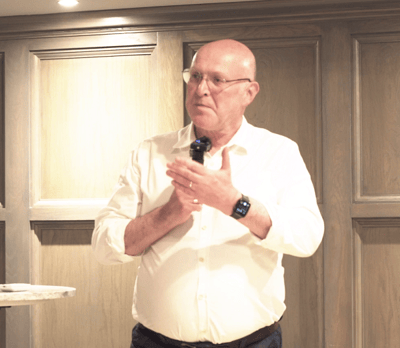- Services
- Solutions
- Technologies
- Resources
- About
-
- +44 (0)203 743 8014
×

For those unfamiliar, the Student Loan Company (SLC) is a prominent UK public sector organisation that extends student funding to scholars across the nation, guiding students through the loan application process, assessment, disbursement and repayment phases. The sheer scale of SLC's operations is staggering. With 1.8 million customers and a loan book totalling £178 billion, the organisation assesses around 2 million applications annually and handles approximately 6 million calls each year. This immense responsibility underscores the necessity for robust digital innovation and customer-centric approaches.
We need to be accessible to everybody, we want to invest in their future and getting an education. So, we need to make sure we're providing really good customer journeys.
- Susan Ritchie, Head of Enterprise Integration at Student Loan Company
Two years ago, Susan Ritchie embarked on a new adventure as the Head of Enterprise Integration for the Student Loans Company. She is a seasoned IT professional with a wealth of experience dating back to 1989, primarily in the financial sector. Her expertise lies in fostering maturity in organisations and leveraging innovative technologies to drive meaningful change. Susan's role involves managing the Center of Excellence, a hub that empowers her team to ensure the effective implementation of MuleSoft integration solutions, fostering a culture of ownership and continuous improvement.
Susan's perspective on digital innovation revolves around providing a range of options to customers, particularly catering to the tech-savvy younger demographic. The aim is to offer accessible and stress-free services that contribute to the well-being of students and, by extension, the UK's future economy.
Central to this vision are the company's strategic objectives:
Susan's role as the Head of Enterprise Integration involves managing a diverse range of cutting-edge technologies, including Salesforce, MuleSoft and Alfresco. This entails nurturing Centers of Excellence (CoE) and empowering teams to ensure the right processes and people are in place. The Enterprise Integration team, specifically responsible for MuleSoft, assumes the role of guardian for the technology, emphasising the importance of making informed decisions, avoiding technical debt and continuously improving processes.
Ready to revolutionise data strategy in your organisation?
Contact us now to explore how MuleSoft's integration capabilities can help you unlock the full potential of your data.
Fireside chat with Susan Ritchie (Head of Enterprise Integration for Student Loans Company) and Chloe Hoggard (Head of UK and Dach Public Sector for MuleSoft), Edinburgh in June 2023.
Around 2019, SLC embarked on a strategic evaluation of its existing business processes and technology infrastructure. The team realised that the organisation's reliance on tightly coupled, monolithic and often outdated systems is a serious obstacle to achieving their desired objectives. It was clear that to meet business goals, a technological shift was needed.
The primary objective was to incorporate technology that streamlined operations, facilitating the delivery of services while optimising expenditures. The foundation was set, and the journey forward included MuleSoft as a critical element of the transformation. However, 2020 witnessed the unforeseen disruption of the COVID-19 pandemic. The original intent behind MuleSoft was to replace an aging Oracle hub solution, thereby reducing technical debt and enhancing operational efficiency. Yet, the pandemic prompted a strategic pivot toward enabling a single customer interface, capable of self-service and engagement.
This strategic shift culminated in the initiation of the Customer Engagement Management (CEM) program, specifically focused on the development of CEM Phase One. Here, SLC encountered a dual challenge. On one hand, the organisation was working to deliver requisite functionalities, while establishing best practices, standards, governance, automation, and deployment pipelines. This dual-track approach created a dynamic where functionality often outpaced the maturation of capabilities – a challenge not uncommon during large-scale transformations.
The pivotal role of the CoE became evident as the journey progressed. As 2021 drew to a close, the Student Loan Company's efforts began to crystallise into tangible outcomes, laying the groundwork for the subsequent stages of their transformational journey.

According to Susan Ritchie, their partnership with MuleSoft was not just about technology, but a strategic shift that empowers SLC to transform and modernise operations.
MuleSoft is a real enabler for our delivering on our on our strategy. It's the thing that glues all things together to make them work.
- Susan Ritchie, Head of Enterprise Integration at Student Loan Company
Think of MuleSoft as the invisible glue that brings various platforms and systems together. While we can see what Salesforce do, MuleSoft works quietly to make them all work together smoothly.
MuleSoft shines in three main ways at SLC. First, it helps connecting Salesforce to other important systems like Alfresco and Okta. It's even behind the new electronic payment system that ensures everyone gets paid on time.
Second, MuleSoft simplifies things by building reusable service integrations, making SLC more flexible and adaptable.
Third, MuleSoft helps retire outdated systems less painful, reducing risks and making things more secure. In fact, SLC's security people are impressed. They say MuleSoft helps them stay on top of vulnerabilities and keeps everything secure.
Susan Ritchie highlighted a fascinating aspect – the rate of reuse. Initially proud of achieving a 50% reuse rate, she admitted being outdone by newer achievements. However, the journey itself is promising.
In June 2022, the rate was at 30%, then climbed to the 40s, and eventually reached the goal of 50%. This upward trend indicates positive movement in the right direction. While there's still a long road ahead, the progress is tangible.
 Norman Sawers, Strategic Account Executive from MuleSoft who worked with the SLC account for years, brought a perspective that resonated deeply with Susan Ritchie's insights. He emphasised that the conversation isn't just about technology; it's about empowering people and entire organisations. It's about aligning technology to specific business goals set by customers. This alignment, he noted, sets MuleSoft and Salesforce apart from others, as they are focused on more than just software functionalities.
Norman Sawers, Strategic Account Executive from MuleSoft who worked with the SLC account for years, brought a perspective that resonated deeply with Susan Ritchie's insights. He emphasised that the conversation isn't just about technology; it's about empowering people and entire organisations. It's about aligning technology to specific business goals set by customers. This alignment, he noted, sets MuleSoft and Salesforce apart from others, as they are focused on more than just software functionalities.
Norman stressed out how the engagement of MuleSoft and Salesforce with their clients goes beyond technical aspects. It's about enabling customer success by working together to fulfil strategic objectives. This collaborative approach isn't just a sales pitch – it's the reality that has been unfolding over the years of partnership.
We're not just talking about the bits and bytes of some software. We're talking about the engagement of ourselves as an organisation with our customers to enable that customer success.
- Norman Sawers, Strategic Account Executive, MuleSoft
Referring to the remarkable 50% reuse rate Susan mentioned, Norman underscored the significance of such metrics. He tied this achievement to the concept of a "composable organisation" facilitated by MuleSoft. In this context, he referred to the example of "lifelong learning" – a government initiative suggesting the creation of a loan for tertiary education, which has implications for Student Loan Company's services.
Susan Ritchie's story, shared at the recent event "MuleSoft Data Strategy PoV for Government" in Edinburgh, demonstrated that technology is not merely a collection of tools but a driving force for organisational transformation. By aligning technology with business objectives, organisations can propel themselves toward success, foster innovation and improve customer services.
Both Susan and Norman emphasised the importance of strategic partnerships in leveraging the power of advanced technologies to reach strategic objectives, foster growth and attain success.
We are passionate and share the joy of igniting ideas to fuel business visions. We are confident and are not afraid to boldly go where we’ve never been. We are also very friendly and approachable people who love to solve problems. Give our curious intelligent learners a challenge and we will make it work.
[fa icon="phone"]+44 (0)203 743 8014
[fa icon="phone"]+44 (0)203 875 5669 (Support)
[fa icon="envelope"]info@infomentum.co.uk
[fa icon="map-marker"]4th Floor
68 King William Street
London, EC4N 7HR, UK